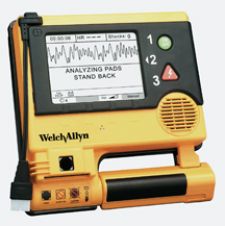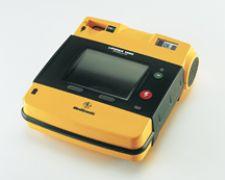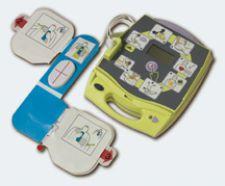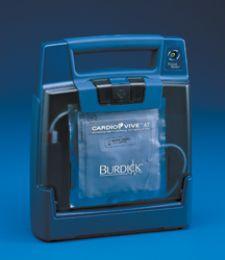
Welch Allyn AED 20
Few medical devices are credited with preventing death and are used so rarely as automated external defibrillators (AEDs), the small, portable, electronic gizmos that can restore the heart’s natural rhythm following sudden cardiac arrest.
Mounting clinical evidence has shown that the units save lives: Government-mandated proliferation of AEDs in public places like airports, casinos and police departments have increased survival rates as high as 74 percent. Until recently, however, outpatient healthcare facilities have been slow to adopt them – too slowly, in fact, for organizations like the American Heart Association (AHA) and physician groups.
Consider these sobering facts:
About 1.1 million Americans each year suffer a heart attack, and one quarter of these people will die before reaching the hospital, according to the AHA.
Successful treatment of ventricular fibrillation/sudden cardiac arrest requires early and fast cardiopulmonary resuscitation and defibrillation. There is a 10 percent decrease in the survival rate for every minute of delay in applying defibrillation, according to the AHA. For example, more than 90 percent of patients receiving defibrillation within one minute of onset survive, while fewer than five percent survive if 10 minutes lapse.
In a March 15, 2006, American Family Physician editorial, Drs. Deborah Witt and Christopher Chambers of Thomas Jefferson University, Jefferson Medical College write, “survival rates after out-of-hospital sudden cardiac arrest remain disappointingly low.” In general, clinical researchers have concluded that there is a higher risk for delayed defibrillation for patients in unmonitored beds, outpatient areas and diagnostics facilities. In fact, outpatient care survival rates for sudden cardiac arrest episodes are dismal – less than seven percent in the U.S., the AHA noted.
In its recent report on the U.S. external defibrillator market, market researcher Frost & Sullivan observes that “despite the long history of external defibrillator placement in hospitals and ambulances, other alternate care medical facilities, such as physician offices, dentists, dialysis centers, and rehabilitation facilities [have been] slow to install devices or even accept the need for them.” The firm notes that the alternate care market has been “reluctant to initiate defibrillation programs” even as the medical field refocused on the tremendous number of deaths caused by cardiac arrest.
Tide is Turning
Recent market trends, however, portend an upswing in AED sales in the outpatient arena, according to Frost & Sullivan. The firm notes that the 2004 outpatient AED market of $321.1 million will increase at a compound annual growth rate of more than 12 percent in the next five years. The firm attributes the trend to increased awareness, as well as “accelerating” government regulations requiring AED placements in specific industries such as the airlines and first responders like EMS services.
What’s driving the up-tick in sales?
AED manufacturers with whom Outpatient Care Technology spoke were unanimous in identifying a number of key trends.
Increased awareness. The market’s appetite for AEDs significantly increased in 2000 following passage of the Cardiac Arrest Survival Act, which promulgated guidelines for AED use in federal buildings such as post offices. Moreover, organizations such as the AHA and the Joint Commission on Accreditation of Healthcare Organizations have led the way.
“The realization that time to defibrillation is the key to best survival rates is a big factor,” said Nancy Sandy, a spokesperson for Deerfield, WI-based Burdick, Inc. (a Cardiac Science company). “With this information becoming more readily available, medical personnel are recognizing the need to have defibrillators in their offices to protect both staff and patients.”
According to Adrian Alvarez, global AED marketing manager for Skaneateles Falls, NY-based Welch Allyn Inc., “Defibrillation is becoming more and more a topic of concern among physicians, and I think we’ll see more and more of them taking a hard look at developing advanced resuscitation plans that go way beyond calling 911. Providers need to be able to respond quickly and in a simple, straightforward manner. In the past, many smaller practices looked at defibrillation as taking the hand-me-down clunker from the hospital and using that.”
Affordability. It’s a buyer’s market today. Market researchers have noted that AED manufacturers are currently competing heavily on price.
Greater patient acuity. Many outpatient clinics today are performing more complex procedures and are seeing more critical patients than ever before; consequently, cardiac arrest risks in clinics and diagnostic facilities are dramatically rising, particularly for high-risk groups such as diabetics and obese patients.
“There’s a huge increase in procedures such as stress testing in the outpatient market, as well as an increased use of new types of drugs that have unpredictable cardiac results,” Alvarez said. Indeed, organizations such as the American Academy of Family Physicians have noted that a large segment of the adult population – as many as 40 million Americans – are susceptible to potentially fatal allergic reactions to new medications such as sedatives and anesthetics.
Increased focus on safety. Anne Devine, a spokesperson for Redmond, WA-based Medtronic Emergency Response Systems, acknowledged that increased AED sales are due in large part to increased liability concerns and the burgeoning patient safety movement, fueled by media exposures of adverse drug events and other medical errors over the past several years.
Devine noted that healthcare providers are increasingly seeing the need to “improve their response times and fit within the changing guidelines for resuscitation.” Legal concerns over improper AED use, meanwhile, have been mitigated by the passage of so-called “Good Samaritan Laws” that protect AED users and owners against liability for device misuse.
Feature-Rich ‘Shock Boxes’
Most AEDs on the market today are a far cry from the stripped down ‘shock boxes’ that first came on the market several years ago.
Perhaps the most attractive feature of an AED is the fact that it allows non-clinical staff with little training to respond to a cardiac emergency. Current guidelines usually require a brief training course that covers both AED use and CPR. Most devices are pre-programmed to analyze the heart’s electrical function and administer the right amount of voltage, measured in joules. Moreover, most devices easily guide the caregiver through the defibrillation process with audible prompts or simple instructions on a small LCD screen.
Common features in many AEDs on the market include biphasic technology, which allows for variable energy outputs; quick charge and re-charge times; on-board memory to store critical event documentation such as ECG data; self-diagnostics; CPR prompts; training materials such as CD-ROMs and DVDs; and software-driven upgrades to keep current with defibrillation guidelines.
Some newer devices also incorporate features such as lower joules and special paddles for pediatric cardiac emergencies. More advanced features in some AEDs include pacemaker pulse detection and wireless data transmission to a computer.
One of the more significant recent innovations in AEDs is the ability to perform “multitiered” response functions, which allow for integration with manual or fixed defibrillators. These new generation “dual mode” AEDs, such as Welch Allyn’s AED 20, Zoll Medical’s AED Pro and Medtronic’s LIFEPAK 20, also incorporate monitoring capability for keeping tabs on vital functions such as blood gases.
What Buyers are Demanding
For now, many buyers in the outpatient market don’t look far beyond price, which can range anywhere from less than $2,000 for a bare-bones device to more than $12,000. “Price is big, and buyers are realizing that AEDs are significantly less expensive than a standard crash cart defibrillator,” Sandy said.
While manufacturers with whom OPCT spoke acknowledged price is a major decision point, buyers can often be shortsighted by greater, unknown cost issues.
“Cost is definitely a factor. But we stress with our customers to look beyond the initial acquisition price,” Alvarez said. “It’s not as if each AED shock gets reimbursed. In most cases, an AED will sit on the wall for months before being used, and providers hope and pray they never have to use it. The long-term cost of ownership is the real differentiator buyers should be looking at.” He pointed to such things as the costs of maintenance, training and replacing parts and supplies, such as shock pads and batteries.
Aside from price, AED buyers in the outpatient market are looking for units that are reliable, safe and easy to use and maintain. “Buyers need to be able to quickly deploy a machine that leads to a positive outcome for the patient,” Alvarez added.
Portability also is high on buyers’ wish lists. Most units weigh less than 10 pounds and don’t require a crash cart for transport.
Sandy called the ease-of-use factor “a no-brainer. The AED accurately interprets the ECG and advises shock or no shock,” she said. “Some AEDs do not require user intervention beyond attaching the electrodes.” User confidence, therefore, is high on a buyer’s list. Sandy said Cardiac Science’s CardioVive AED units incorporate daily self-diagnostic tests of the internal circuitry and battery, and confirms that paddle pads are properly attached. “The algorithms used by the CardioVive better tune energy delivery to patients based on impedance measurements,” she said. “Reviving a 95-pound ballerina requires less energy than a 400-pound Sumo wrestler.”
Buyers also tell suppliers they demand AEDs that stay abreast of ever changing clinical practice and guidelines, including the newly updated American Heart Association Guidelines for Cardiopulmonary Resuscitation and Emergency Cardiovascular Care, as well as the 1996 International Liaison Committee on Resuscitation (ILCOR) guidelines, released at press time. Staying current with guidelines, in fact, may be the most important feature of any AED on the market today.
“Very few people in the outpatient market who would use an AED are cardiac specialists, so it’s critical they understand the guidelines,” said Hank Constantine, marketing director, Public Access, for Burlington, MA-based Zoll Medical Corp. “There is a learning curve with these units and untrained people can’t get carried away with the notion that an AED is so simple to use that simply pushing a button saves a life.”
Constantine said Zoll Medical’s two AED models – the AED Plus and AED Pro (dual-mode) – include the company’s proprietary “Real CPR Help” feature, a highly intuitive program that constantly interprets and responds to the depth and frequency of chest compressions. The units include a special pad that incorporates the paddles, as well as a puck-like device where hands are placed to do CPR compressions. The AED guides the caregiver with audible instructions and beeps using an adaptive metronome effect if they are doing it correctly or need to give harder or faster compressions.




